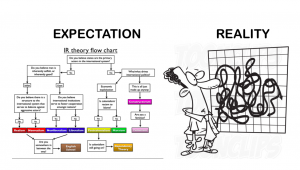
The rapid rise of globalization and technological advancement have narrowed the borders between nations. This is the reason why I find it interesting to study the foundations of international relations in the modern era to the postmodern era.
My expectation of the class included simply differentiating the theories and looking at the relationship between nations from a variety of lenses. However, in the postmodern era, the essential truth of things is at the centre. Thus, international relations has been more complicated than before.
Internal relations as a subject began with realism as the core paradigm. Realists mainly focused on explaining the war whether it was caused by human drives, self-interests, cohension of the community, and balance of power.
Realists aimed at studying international relations as a natural science, so they used empirical methods and disregarded other theories that disagree with them. As we all know, international relations and state actors’ motivations are difficult to predict and study empirically. Furthermore, international relations can’t be a natural science because it is dynamic and it changes overtime unlike physics where the law of gravity never changes. It is no wonder that realism has been in decline especially in the era we are currently in.
Structural realism is even worse since it focused on the degree of power that states possess and ignored the differences between the states’ culture and regime. These differences are of course necessary when determining how states make their decisions in relation with other states and who makes these decisions. The regime type for instance influences how a state deals with military power. Structural realists assume that states are rational beings, ignoring other factors that are essential in analyzing state actors.
Structural realists also believe that a unipolar system would bring about peace or help maintain peace. As we see, while the US is one of the most powerful states, their decisions and response to international issues are not always rational or beneficial to majority of the states or sometimes even to its own state.
Structural realists’ assumptions are based on the balance of power, but because of the complications of the narrowing of borders and inevitable encounter between states in the 21st Century, there are many more factors to take into account other than military power and security.
Going forward with the course, I am interested to learn more about sovereignty of states in the postmodern era, the importance of NGOs, the limitation of international intervention, and the power relationship between first-world and third-world countries from theories that see international relations as more than a natural science.
